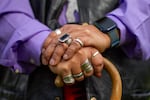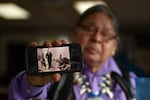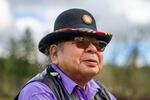
Ed Edmo, Shoshone-Bannock, holds up his stuffed bald eagle puppet as he poses for his photo in front of the "A Place Called Home" mural inside the Portland airport, created by Portland artists Jeremy Nichols and Alex Chiu.
Jarrette Werk / Underscore News / Report for America
This story originally appeared on Underscore.news.
Many who grew up in the Pacific Northwest recognize Ed Edmo by his expressive hands and face as he tells stories, breathing life into characters like Nasho, a monster woman, and cultural tricksters like the Coyote and Spider Woman. He changes his voice, making it high for the women’s parts and low for the men’s. Sometimes he incorporates puppets or asks the audience to help him, urging them to repeat after him.
Ed Edmo, Shoshone-Bannock, is a traditional storyteller, poet, playwright, published author, actor, performer, instructor and tour guide who lectures on cultural issues at cultural sites in the Pacific Northwest, such as the flooding of Celilo Falls, as well as drug and alcohol abuse and mental health for Native peoples. He has also served as a consultant to the Smithsonian Museum of the American Indian in Washington D.C.
He tells a story of a monster with “long hair, claws for fingers, snaggly teeth, snot down to here, and bad breath,” asking the audience to repeat those descriptions with him every time he mentions the monster, utilizing hand motions and facial expressions to fully immerse his audience in the story. As his hands wave through the air, the light catches on his silver and turquoise rings—one on almost every finger. Edmo says this is an audience favorite.
“Stories were told to teach children how to act,” shares Edmo. “…how to treat their elders, how to interact with nature and the world.”

Ed Edmo’s hands are adorned with jewelry, many are repurposed silver spoon handles that he now wears as rings.
Jarrette Werk / Underscore News / Report for America
Once Edmo is on a roll, it’s hard for him to stop. He loses time, as does the audience, immersed in the moment. He tells story after story, as long as the audience is engaged. His stories explain how things work or why they are the way they are. He brings the stories and legends of his culture alive. It feels like you’re a part of the story. You can smell the wood burning, feel the bee sting, taste the salmon eyeball soup, and smell the meat cooking because of the way he tells it. He uses props like a cane and puppets of a bear, goose, coyote and eagle to help illustrate his stories.
Edmo grew up listening to his father’s stories. He remembers the crackling fire and his mom, grandmother, and aunties quilting around it as they sat and listened.
“At the time, I didn’t realize it wasn’t just stories,” Edmo said, stroking his salt-and-pepper braids. “It was my dad giving me my culture night by night.”
Native resiliency
With a birth story like Edmo’s, it’s no wonder he grew to become the traditional storyteller he is today. When Edmo was born on the Duck Valley Indian Reservation in Nevada in 1947, he was so small and weak, the delivery doctor gave him five minutes to live. Seventy-six years later, he is not only alive, but thriving. While still small in stature, Edmo’s gravitas and impact on contemporary Native culture in the Pacific Northwest is anything but.
Edmo is a living testament to Native resiliency. Shortly after he was born, his family moved back to his father’s ancestral home at Celilo Village near The Dalles along the Columbia River. His paternal family’s homelands are in the Columbia Gorge. The Celilo Wy-am people are best known for what is currently known as Celilo Falls, where the river once flew down a torrential drop of over 20 feet between bluffs on the shorelines made from basalt. These were the ancestral fishing grounds for the Celilo Wy-am people, where they speared salmon while standing on rocks surrounding the falls. Later, they created platforms across the rocks from which they caught fish in nets.
When Edmo was just a young boy, The Dalles Dam flooded Celilo Falls. Before the flooding, the falls provided everything that the Celilo Wy-am people needed: from salmon, sturgeon, smelt, and eel to traditional roots and berries along the riverbanks. After the falls were flooded, their land base went from over 108 acres to what is now just over seven acres.

While eating lunch at one of his favorite local cafes, Ed Edmo shares a photo taken of him as a young man (center) singing in the drum circle while occupying the Portland Area Bureau of Indian Affairs office on Nov. 11, 1973. Also pictured, Al Smith (right) and Bear Cub (back right).
Jarrette Werk / Underscore News / Report for America
To keep that history alive, Edmo teaches students and community groups in the Pacific Northwest about Celilo Falls and the Celilo Wy-am people. During one of his presentations, Edmo shared slides on Celilo Falls.
“I couldn’t believe how something so big and beautiful could disappear,” he said.
Edmo was raised by both his parents and attended elementary school at Petersburg School in The Dalles, which was a one-room schoolhouse.
“I didn’t realize it was so small,” Edmo said. “When I was so little, it seemed big!”
He graduated from Wishram High School, where he first started getting involved in performance art as a drama student. In 1974, Edmo met his wife, Carol, in Portland. He said they heard about each other through various friends and relatives. They got married in 1976.
Edmo is now in recovery from alcohol and lives a clean and sober life. He goes to Alcoholics Anonymous meetings to stay sober.
“I’m following the path,” he shares.
Grandfather Storyteller
In addition to storytelling, Edmo is a renowned poet and writer. In 1974, he received a grant from the Potlatch Fund for his poem “These Few Words of Mine.” At the time, he was attending Portland Community College.
“I write about contemporary moments in time for contemporary Indians,” said Edmo. “…poems about drinking coffee and raking leaves, about my parents when I was a kid.”
Poems with titles like, “Grandfather Storyteller,” and, “Burnside Cowboy.” Edmo’s most famous poem is “Indian Education Blues.” He wrote it in 1968 in Bend, Oregon. Now, it’s a part of the cultural exhibit “Poetry in Motion,” which features poetry on TriMet transit buses and light rail.
He keeps a beaded pen on him, calling it his “weapon.” He explains that, as a writer, the inspiration to write can hit at any time or any place. One time, he left his journal in the car when he stopped at a Dairy Queen. There was a family in the restaurant, and he was compelled to write a story about them based on their expressions and interactions with each other and the staff, creating a whole backstory from his imagination. He wrote it on a napkin.

Ed Edmo, Shoshone-Bannock, is a traditional storyteller, poet, playwright, published author, actor, performer, instructor and tour guide who lectures on cultural issues at cultural sites in the Pacific Northwest.
Jarrette Werk / Underscore News / Report for America
Sharing culture
His writing and storytelling has recently been memorialized as part of a collection of murals of Portland icons, entitled “A Place Called Home” in the Portland International Airport. The mural of Edmo depicts him dressed in a blue button-down shirt with his iconic suspenders, traditional beadwork, and his long hair in two braids. Above his dapper black hat, Edmo holds one of his favorite storytelling props: a stuffed eagle.
When the mural was first unveiled, Edmo attended and sang a song for the airport employees. Edmo has spent his life sharing his culture and supporting his community – in this, and many other ways. He currently serves on the board of Red Lodge Transition Services, a program for women reentering Clackamas County after prison. He teaches cultural classes at Coffee Creek Women’s Penitentiary, and storytelling classes at Gresham High School. He says he is also looking forward to performing at the Fisher Poets Gathering in Astoria at the end of February.
He finds time to dance and run sweat lodges at various men’s prisons in the Pacific Northwest where he serves as a traditional dancer. He says he doesn’t believe in competition dancing, where dancers get paid for their performances.
While he admits he used to charge people coins or candy for pictures of him in his regalia when he was younger, he says he believes in the tradition of dance as ceremony and to promote healing in the community.
“At Celilo, we danced for the fun of it, not for competition,” he says.
Underscore is a nonprofit collaborative reporting team in Portland focused on investigative reporting and Indian Country coverage. It is supported by foundations, corporate sponsors and donor contributions. Follow Underscore on Facebook and X.